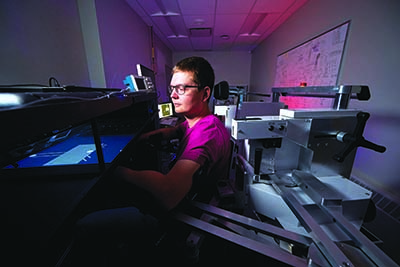How Do We Learn Complex Motor Skills?
 Specialized robotics are shedding light on how the brain learns new motor skills
Specialized robotics are shedding light on how the brain learns new motor skills
By Crystal Mackay, MA’05
Something as seemingly simple and everyday as buttoning your coat, is actually an immensely complex action.
It requires getting and computing inputs from the skin and muscles of your hands and fingertips to understand where the button is in your hand, its size and shape, and where it is in relation to the button hole. The brain and spinal cord then have to interpret and understand those inputs in order to tell dozens of muscles in your hands in fingers to make very small movements and extremely accurate forces to manipulate the button through the hole.
Andrew Pruszynski, PhD, is fascinated by this complexity.
“Of all that things that make humans unique, the extreme specialization of the hand is certainly an outlier,” said Pruszynski, Associate Professor in Physiology and Pharmacology and Canada Research Chair in in Sensorimotor Neuroscience. “Your hands and arms have to be precise enough to thread a needle, but also have to be able to generate a significant amount of strength to open a jar.”
“We realized that the limitation wasn’t on the robotics end, it was really on the neuroscience end. That’s what led me to do a PhD in neuroscience and start studying the sensorimotor system.” — Andrew Pruszynski, PhD
As a scientist at Robarts Research Institute, his research is focused on understanding how the signals from the body, specifically from the skin and muscles, contribute to making accurate, precise movements of the hands and arms. His research helps us to understand how the brain learns to perform new motor skills, and also can help improve therapy for patients trying to relearn their movements after trauma, disease or injury.
Although, his research didn’t begin in neuroscience. Studying robotics as an undergraduate student, he was part of a team that developed a robot intended to wheel up to a patient’s bedside to help them with rehabilitation after a stroke. What they quickly realized was that they didn’t know what to tell the robot to do because there just wasn’t enough known about how the brain learns or relearns motor skills.
“We realized that the limitation wasn’t on the robotics end, it was really on the neuroscience end. That’s what led me to do a PhD in neuroscience and start studying the sensorimotor system,” he said.
He still uses specialized robotics in his research, but now it is in order to manipulate the hand and arm to track both voluntary and reflexive movements, coupled with tools that measure the electrical signals in the nerves, skin and muscles. They do this in order to glean important insights about how these inputs influence how people learn or relearn how to move.
“People have been fascinated by this learning process within the brain for a long time,” he said. “When you are learning new motor skills, you are constantly changing the pattern of motor command that is sent from the brain to the muscle.”
He gives the example of learning to throw darts. If you are throwing with a t-shirt on, the resistance and the inputs from your skin and muscles is going to be slightly different than if you were throwing the same dart with a heavy sweater on.
 The first time you aim for the target wearing the sweater, you might throw really off-target, but your brain will adjust very quickly on the second trial. Most of this change is voluntary – we are making this change consciously through repetitive practice. Pruszynski’s team has shown that while you are doing this voluntarily learning, your reflexes are learning as well.
The first time you aim for the target wearing the sweater, you might throw really off-target, but your brain will adjust very quickly on the second trial. Most of this change is voluntary – we are making this change consciously through repetitive practice. Pruszynski’s team has shown that while you are doing this voluntarily learning, your reflexes are learning as well.
And for the first time, he and his team have also shown that the opposite is also true. Training our reflexes can later transfer to voluntary execution of the skill.
“Getting good at throwing darts, or pretty much any motor skill, requires that the nervous system learns to coordinate many joints,” he said. “This learning is usually thought of as a deliberate and voluntary process. But we’ve actually shown that simple reflex responses learn new coordination patterns even when the person is ignoring the skill being taught.”
They were able to show this by having a person sit in an exoskeleton robot that moved their arm and hand in a particular way to evoke their stretch reflexes. They had the person completely ignore the movement; to just relax their arm and let the robot do the work.
After an hour, the research participant was asked to move their arm and the team was able to show that they had changed their movement in a way that indicated that they had learned from the reflexive action.
These findings not only contribute to the broader understanding of the neural circuits that let people learn new motor skills, but also have direct implication for the rehabilitation of patients trying to re-learn their movements after various motor disorders like stroke.
“You can imagine that you could have someone sit in a robot and relax and watch a movie, and you can train them to learn new motor skills without actually doing the skill,” he said.
From his early days of designing robotics for stroke patients, to this latest discovery, his research really has come full circle.
 Daring to Ask is a series that profiles Canada Research Chairs and Endowed Research Chairs at Schulich Medicine & Dentistry. These researchers are advancing knowledge in their respective fields, asking and answering questions that challenge that status quo and seeking to improve patient care. It is essential research made possible by generous donors and the investment of funding agencies.
Daring to Ask is a series that profiles Canada Research Chairs and Endowed Research Chairs at Schulich Medicine & Dentistry. These researchers are advancing knowledge in their respective fields, asking and answering questions that challenge that status quo and seeking to improve patient care. It is essential research made possible by generous donors and the investment of funding agencies.








